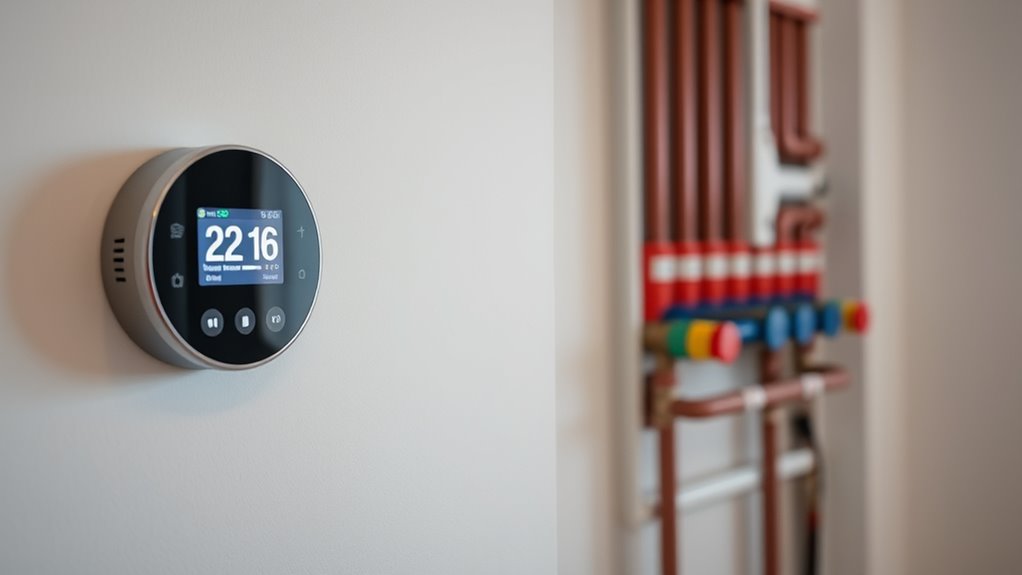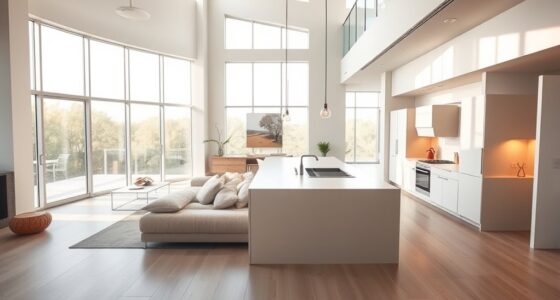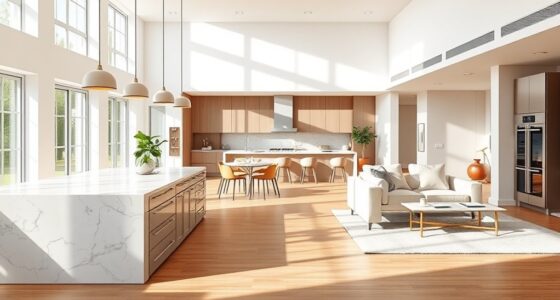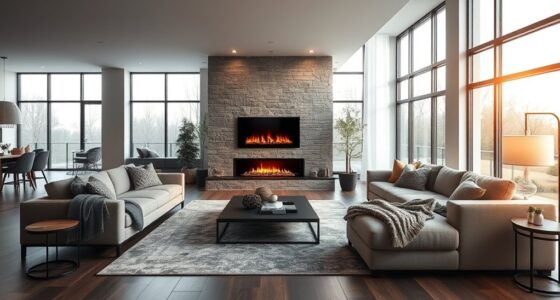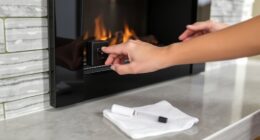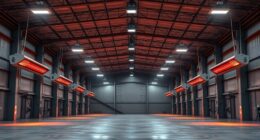Zoned heating systems can save money but have hidden costs beginners often overlook. These include unexpected energy waste from improper setup, high initial equipment and installation expenses, and ongoing maintenance costs. Poor design, setup errors, or imbalanced zones can lead to discomfort and higher bills. To avoid these pitfalls, proper calibration, professional tuning, and regular system checks are essential. Stay informed to guarantee your system works efficiently and keeps costs in check.
Key Takeaways
- Poor calibration or inconsistent thermostat settings can cause uneven heating and higher energy costs.
- Neglecting professional tuning and regular maintenance may lead to system imbalance and hidden expenses.
- Improper zone design or installation increases initial costs and risks inefficient operation.
- Ignoring energy waste from constant or unnecessary system operation raises bills unexpectedly.
- Failing to verify and adjust settings regularly can cause long-term system damage and costly repairs.
Unexpected Increase in Energy Consumption
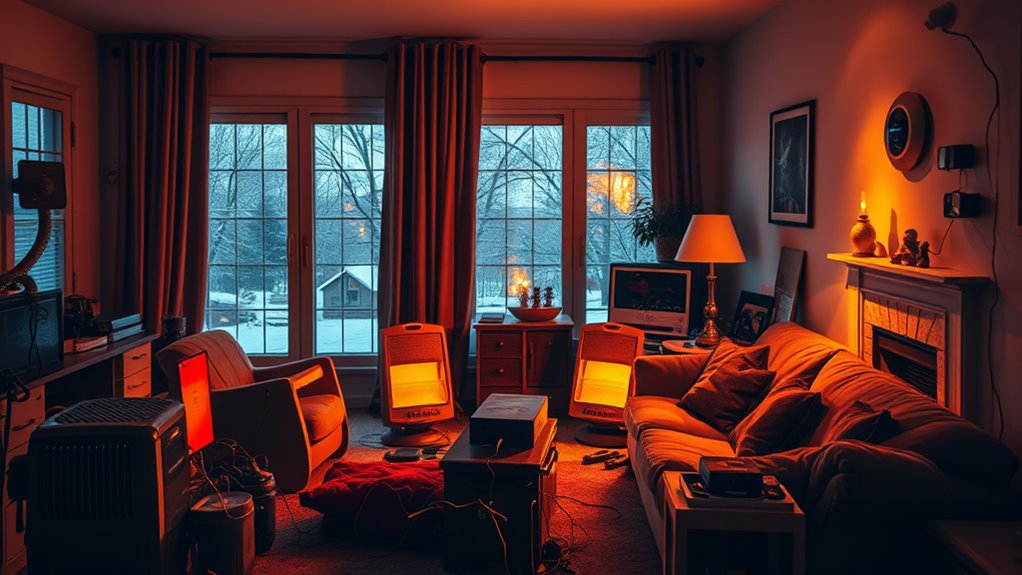
Sometimes, your energy bills spike unexpectedly, and it’s not always clear why. One common cause is energy waste resulting from thermostat mismanagement. If you set your thermostat too high or too low, your heating system works harder than necessary, increasing energy consumption. Leaving your thermostat at a constant temperature or making frequent adjustments can also lead to unnecessary energy use. Zoned heating systems require precise control; if zones aren’t properly managed, some areas may become overheated or underheated, wasting energy. Additionally, neglecting to program your thermostat or failing to use smart controls can cause your system to run longer than needed. Proper temperature regulation is essential for efficiency and comfort. By understanding how thermostat mismanagement contributes to energy waste, you can take steps to optimize your settings and reduce unexpected spikes in your bills.
High Initial Investment and Equipment Costs
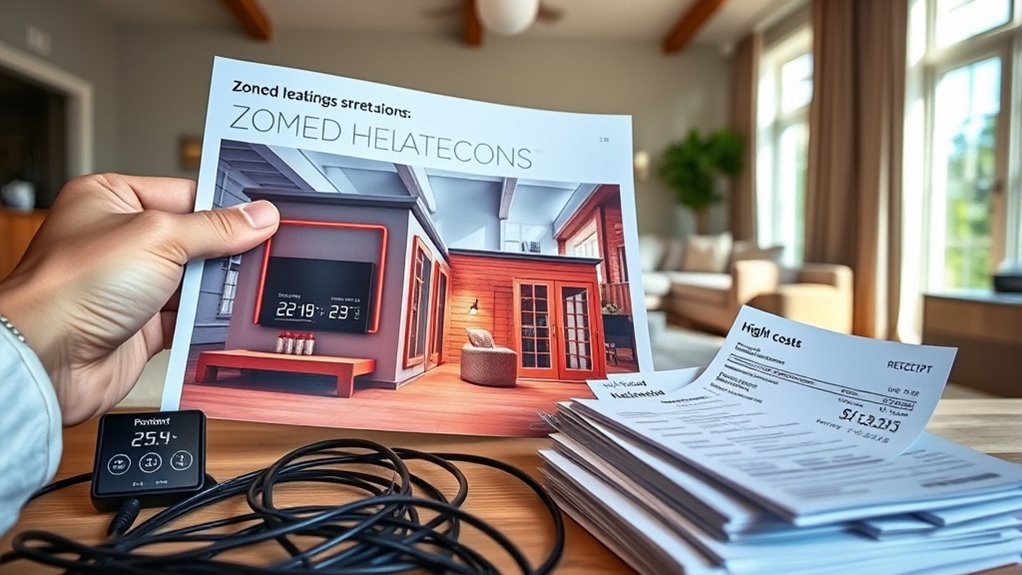
When you install zoned heating, you’ll face significant equipment purchase expenses and installation costs. These upfront investments can be substantial, requiring a strong financial commitment before you see any energy savings. Understanding these initial expenses is key to evaluating whether zoned heating suits your budget. Additionally, the cost of ownership over time can impact your overall budget, especially if maintenance or upgrades are needed.
Equipment Purchase Expenses
Purchasing zoned heating equipment requires a significant upfront investment, which can be a major hurdle for many homeowners. The cost of zoning control systems varies depending on the complexity and brand, often making it a sizable expense. Additionally, you’ll need to verify your thermostat compatibility, as not all thermostats work seamlessly with zoning systems. Upgrading or replacing thermostats to match the new setup can add to your costs. High-quality zoning control systems can improve efficiency, but they come with higher price tags initially. Keep in mind that these expenses are investments toward better energy management and comfort, but they can strain your budget upfront. Careful planning and researching compatible equipment can help you avoid overspending on unnecessary features. Understanding the Volkswagen Tuning options available can also guide you in selecting energy-efficient components that may reduce long-term costs.
Installation and Setup Costs
Installing zoned heating systems involves a significant initial investment that can impact your budget upfront. Accurate cost estimation is essential to avoid surprises later. The setup costs include more than just equipment; they cover installation labor, system configuration, and potential modifications to your existing infrastructure. To better prepare, consider these key points:
- Hiring professional installers can add to your expenses but ensures proper setup.
- Upgrading your existing ductwork or adding zoning controls may increase costs.
- Initial equipment costs are higher than traditional systems, influencing your budget planning.
- Recognizing the importance of digital literacy programs can help in understanding and managing your new system effectively.
Upfront Financial Commitment
Investing in a zoned heating system requires a substantial upfront financial commitment, as the initial costs are considerably higher than traditional setups. You need to carefully plan your budget, accounting for the price of advanced thermostats, zone dampers, and possibly new ductwork. This larger investment increases your financial risk, especially if you’re unsure about long-term savings or if your home’s layout changes. Proper budget planning helps you avoid unexpected expenses and ensures you’re prepared for the initial outlay. Keep in mind that while the upfront costs are significant, they can pay off over time through improved efficiency and comfort. However, understanding these financial demands upfront allows you to evaluate whether the potential benefits outweigh the initial investment. Additionally, considering the sound quality of your system and its components can prevent additional costs related to noise issues or system repairs down the line.
Complex System Design and Installation Challenges

Designing and installing a zoned heating system can be particularly complex because it requires precise coordination of multiple components to guarantee each zone receives the appropriate amount of heat. This involves intricate system integration, where different elements like thermostats, dampers, and control panels must work seamlessly together. Control complexity increases as you try to balance comfort and efficiency across zones. To manage this, you need to contemplate: 1. Proper placement and wiring of thermostats for accurate readings 2. Compatibility of various hardware components for smooth system integration 3. Programming the control system to handle dynamic adjustments effectively. Additionally, selecting appropriate zone controls is critical to ensure reliable operation and ease of troubleshooting. Failing to address these factors can lead to installation delays, increased costs, and operational issues, making the initial investment more challenging than it appears.
Ongoing Maintenance and Repair Expenses

While a zoned heating system can offer enhanced comfort and efficiency, it also requires ongoing maintenance to keep it functioning ideally. Regular upkeep is essential to prevent costly repairs and ensure peak performance. You should incorporate maintenance scheduling into your budget planning to avoid unexpected expenses. This includes routine tasks like checking dampers, sensors, and thermostats, as well as inspecting ductwork for leaks or blockages. Neglecting these upkeep activities can lead to system inefficiencies and higher repair costs over time. Staying proactive with maintenance helps extend the lifespan of your zoning system and keeps energy savings on track. Additionally, using proper tools and techniques can facilitate easier inspections and repairs, saving you time and money. By allocating funds regularly for maintenance, you prevent small issues from turning into major, costly repairs, ensuring your investment pays off long-term.
Inefficient Zoning Due to Poor Setup or Usage
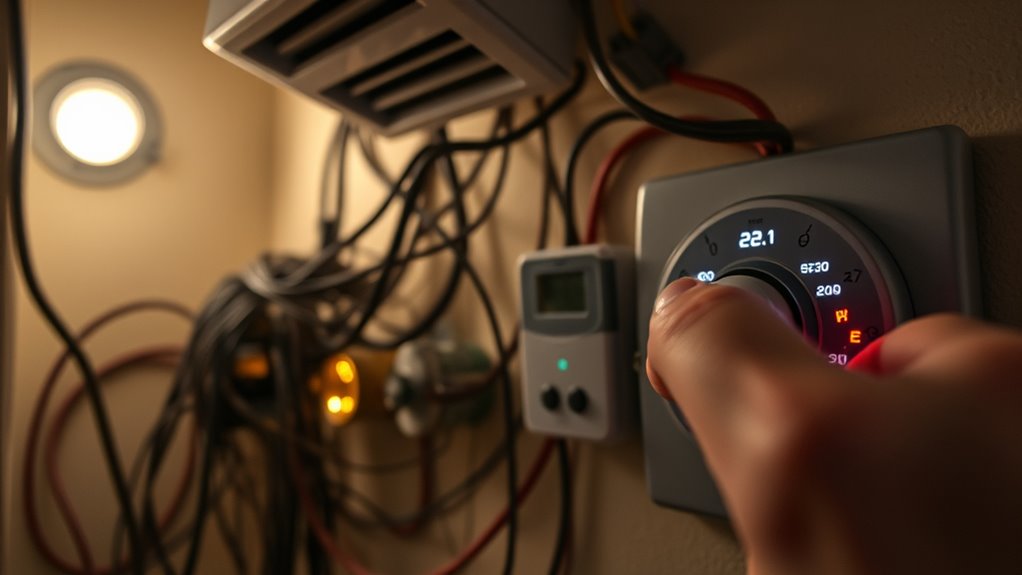
Poor setup or incorrect usage of your zoning system can considerably reduce its efficiency, leading to higher energy bills and uneven heating. Common user errors include neglecting detailed zoning instructions, misprogramming thermostats, or failing to calibrate sensors properly. To avoid this, make sure you:
- Follow detailed zoning guidelines when installing or adjusting your system.
- Regularly verify that thermostats are set correctly for each zone.
- Calibrate sensors to ensure accurate temperature readings.
These simple steps can prevent inefficient zoning caused by user errors. Poor setup not only wastes energy but also undermines the benefits of detailed zoning, leaving some areas too hot or too cold. Proper setup and correct usage are vital for maximizing your zoned heating system’s efficiency and saving money.
Potential for Imbalanced Heating and Comfort Issues
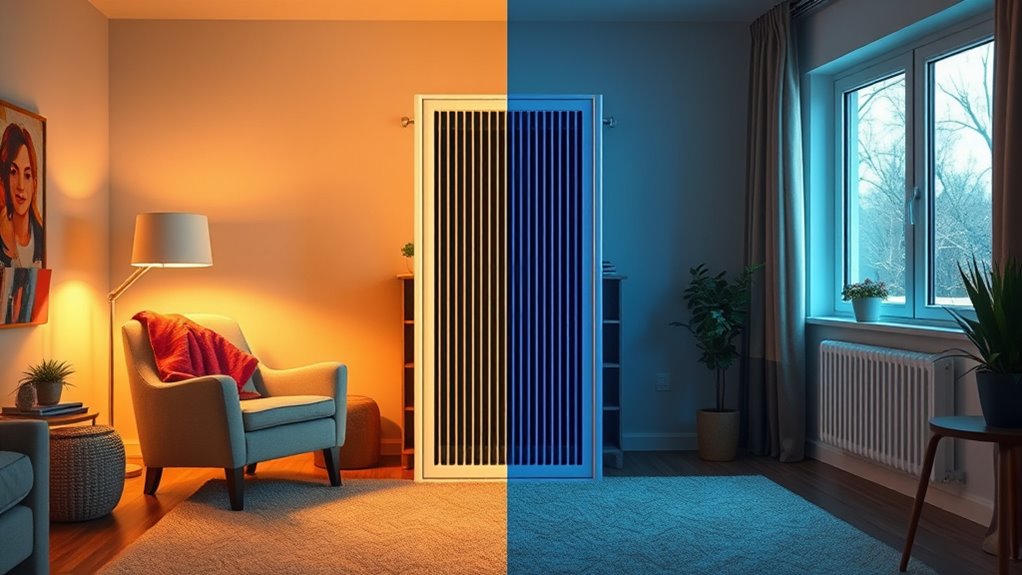
Imbalanced heating often occurs when zoning systems aren’t properly calibrated or if there are inconsistencies in how thermostats are set across different zones. This can lead to differential heating, where some areas become warmer or cooler than intended, causing discomfort. Zone imbalance happens when certain zones receive more heat while others remain underheated, undermining your comfort and energy efficiency. If thermostats aren’t synchronized or if the system isn’t correctly tuned, you might notice uneven temperatures throughout your home. This not only affects your comfort but can also increase energy costs as the system works harder to compensate. Proper Kia Tuning of the system can help prevent these issues by ensuring consistent performance across all zones. To avoid these issues, verify your zoning system is properly calibrated and that thermostat settings are consistent across zones.
Frequently Asked Questions
How Can I Prevent Zoning From Increasing My Energy Bills?
To prevent zoning from increasing your energy bills, you should install smart thermostats for precise control and set them efficiently. Additionally, verify your zone insulation is effective; well-insulated areas retain heat better, reducing unnecessary heating. Regularly update your system settings and monitor usage to avoid over-heating unoccupied zones. These steps help you save energy, lower costs, and make your zoned heating system more efficient.
What Are the Best Practices for Maintaining Zoned Heating Systems?
Your zoned heating system is your home’s heartbeat, so keep it in top shape. Regularly calibrate thermostats to verify accurate temperature control, and don’t overlook zone valve maintenance—stuck valves can cause uneven heating and energy waste. Check filters, inspect wiring, and schedule professional tune-ups annually. By staying proactive, you’ll maximize efficiency, extend system life, and enjoy cozy comfort without unexpected surprises or skyrocketing bills.
How Do I Select the Right Zoning Equipment for My Home?
To select the right zoning equipment, start by evaluating your home’s compatibility with various systems. Consider your home’s size, layout, and insulation, then choose zoning equipment that suits these factors. You should also compare features like control options and energy efficiency. Consulting with a professional can help guarantee you pick equipment that integrates seamlessly, avoiding hidden costs and maximizing comfort and savings for your specific home.
Can Improper Setup Lead to Uneven Heating in My Zones?
Yes, improper setup can cause uneven heating in your zones. If your thermostat isn’t calibrated correctly, it may not accurately reflect the room temperature, leading to over- or under-heating. Additionally, duct sealing is essential; leaks can cause uneven airflow, resulting in hot or cold spots. Make sure your thermostat is properly calibrated and ducts are sealed to maintain consistent temperatures across all zones and avoid discomfort.
What Are Common Mistakes to Avoid During System Installation?
Imagine your system as a delicate dance—every step counts. To avoid zoning conflicts and installation errors, double-check that your zones are properly sealed and wired correctly. Don’t rush through the setup; misaligned dampers or faulty wiring can create uneven heating and energy waste. Keep detailed plans, follow manufacturer instructions, and consult professionals if unsure. This careful approach guarantees your system flows smoothly, keeping your home cozy and efficient.
Conclusion
Watch out, because without careful planning, zoned heating can turn your home into a money-sucking monster! Unexpected energy spikes, sky-high upfront costs, and endless maintenance might make you wish you’d never tried zoning at all. If you’re not meticulous with setup and usage, you’ll end up battling uneven warmth and spiraling expenses. So, stay alert, plan wisely, and avoid these hidden costs—your wallet will thank you for it!
